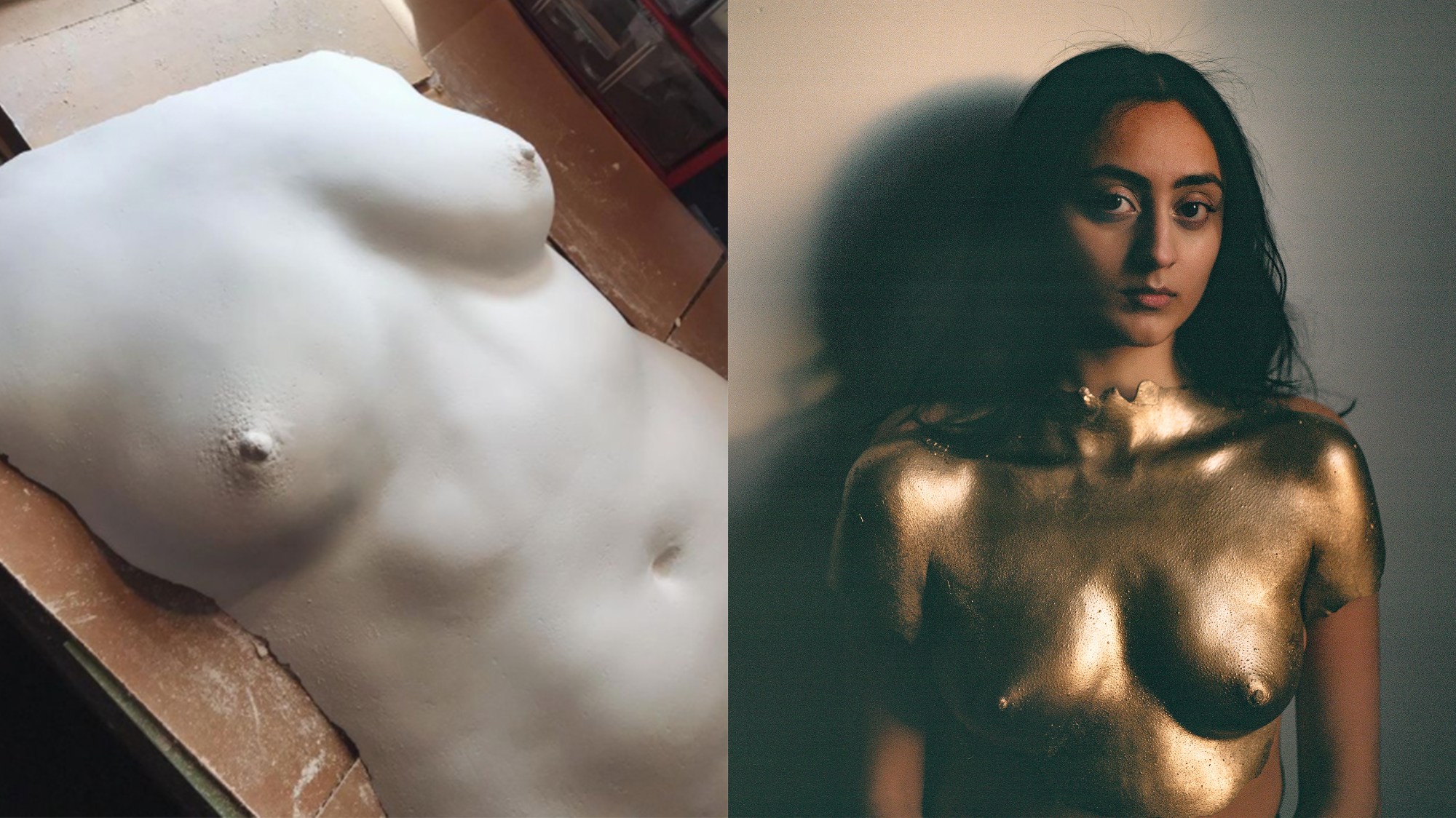Misha Japanwala was working in luxury fashion in New York when she first met Gigi Hadid backstage at a show. The model was already following her on Instagram, but the two had never exchanged words. Misha’s colleague pushed her in front of Gigi, forcing her to say hello. “And she was so wonderful,” Misha says. A few short years later and Misha was handpicked to collaborate with Gigi on a custom breastplate for the model’s guest issue of V Magazine, a very “surreal moment”, she says.
Gigi’s shoot in V was a crucial moment for the 25-year-old sculptor, artist and breastplate designer, but that’s not to say she hadn’t already pocketed some prestigious credits. Back when she graduated from Parsons School of Design in 2018, Vogue Spain featured her undergraduate thesis collection, modelled by Cindy Bruna, in a striking multi-page spread. This year, things are only heating up now that Misha has been named one of Forbes 30 Under 30 artists in Asia last month.
So, what is it about her work that has piqued the fashion world’s interest? Well, more than create garments, the Pakistani designer moulds wearable art: gold and silver-plated breastplates with signature scalloped edges. Some are painted with Urdu lettering, featuring words like “Azaadi“ (meaning “freedom”); others are more renaissance-like; simple outlines of the female body, but detailed in each curve, fold and arch.
And it’s all the more impressive when learning that, despite the clarity of her vision, Misha began work on these elaborate designs without having any prior knowledge of body moulding. To begin with, she would simply stand in her bedroom and paint silicone and plastic over her body, slowly perfecting her form. “I had spent an initial few years [at university] kind of stumbling around, finding an aesthetic and a message that really resonated with me,” she says. “I thought a lot about the female body, what it represents and people’s reactions to them. That was the beginnings of my art.”
Misha’s work also comes at a moment when breastplates have reentered our cultural conscience with a bang. Though these seductive structures once appeared on runways (think Issey Miyake, Thierry Mugler and Alexander McQueen back in the day), it’s designers like Sinéad O’Dwyer in London, and collections like Tom Ford Spring 2020 that have catalysed a renaissance. Misha calls it a “rebirth”, one that combines tradition with modernity. “We’re imagining the new without leaving the old completely behind.”
Nowhere is this ethos clearer than in the way she incorporates her Pakistani heritage. In 2018, according to the Global Gender Gap Index, Pakistan came sixth in a poll of the most dangerous countries for women and the second to last for gender equality. Growing up reading a daily newspaper in Karachi that brought news “every single day” of “an honour killing or a very violent attack on a woman”, Misha feels strongly about this epidemic. “[I read] article after article about this violence in Pakistan and [I am] very intensely and critically thinking about my upbringing as a woman in Pakistani society,” she says. “Pakistan is very rooted in patriarchal structures. I think that it affects every woman within the culture, in varying degrees and in different ways. But it touches everyone.”
Urdu messages — words like “powerful”, “strong”, and “my body, my choice” — are imprinted with delicate black lettering onto the body casts Misha hand-makes. It all feeds into a conversation about what women in Pakistan and South Asia at large face daily, and, on Instagram, she frequently delves into these topics; safety for womxn, foundations of oppression, and women’s issues in the region. She recognises that these are widespread, structural concerns, despite her primary emphasis on Pakistan. “Violence against women isn’t a regional or cultural issue,” she says. “It happens everywhere, every day.”
And it’s not without pushback. The designer rarely goes a week without receiving a backlash online. Her self-appointed critics question the “obscenity” of creating body moulds, with many believing she promotes nudity and artwork that is at direct odds with her country. “When I started publicly sharing my work, I got a lot of comments like, ‘Why do you only focus on the negative parts of Pakistan? Why aren’t you proud of your culture?’ But I think that’s such a skewed way of looking at what I’m doing. It’s because I love my country and my culture that I want to explore these thoughts in my art.”
“We’re so used to seeing men depicting the female body,” she adds. “We then congratulate them for this work. But for a woman to create this work about her own body? We’re threatened.” More than just art or clothing, these body casts are reclamations of womanhood in themselves. Within each mould, each carved nipple, and each gold-flaked breast, lies a celebration and exploration of the female body: intimate, flawed and worthy. “With body casting, your raw material is the body itself. The creation is the body. I’m just reinterpreting it.”

